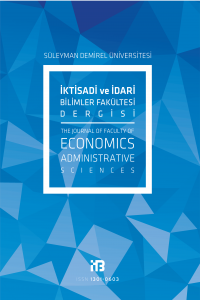KUSURLU ÜRETİMİN OLDUĞU BİR EKONOMİK ÜRETİM MİKTARI MODELİ
Ekonomik Üretim Miktarı, Kusurlu Ürün, Yeniden İşleme
AN ECONOMIC PRODUCTION QUANTITY MODEL WITH DEFECTIVE PRODUCTION
Economic Production Quantity, Defective Product, Rework,
___
- AYDEMİR, E. (2015). “Envanter Yönetimi ve Uzantıları: Ekonomik Üretim Miktarı Modelleri Üzerine Bir Bilimsel Yazın Araştırması”, Anadolu Üniversitesi Sosyal Bilimler Dergisi, 15 (3), 97-112.
- CHAN, W.M., IBRAHIM, R.N. & LOCHERT, P.B. (2003). “A New EPQ Model: Integrating Lower Pricing, Rework and Reject Situations, Production Planning and Control”, 14(7), 588-595.
- DEMİR, H. ve GÜMÜŞOĞLU, Ş., (2003). Üretim Yönetimi (İşlemler Yönetimi), Beta Yayıncılık.
- EROĞLU, A., (2002). Deterministik Envanter Modelleri (1. Baskı), Fakülte Kitabevi.
- EROĞLU, A. & ARSLAN, P. (2022). “New Expansions In The Economic Production Quantity Model Containing Defective Products”, International Journal of Engineering and Innovative Research, 4(2), p:126-133.
- EROĞLU, A., SÜTÇÜ, A. & SULAK, H. (2008). “Rassal Olarak Kusurlu Üretim Yapan Üretim Süreçleri için Ekonomik Üretim Miktarı Modeli”, Gazi Üniv. Müh. Mim. Fak. Der., 23(4), 923-929.
- EROĞLU, Ş. & ŞAHİN, Y. (2023). “Geri Dönüşüm Süreci için Yeni Bir Bulanık Envanter Modeli”, Dokuz Eylül Üniversitesi Mühendislik Fakültesi Fen ve mühendislik Dergisi 25(7), 21-36.
- HAYEK, P.A. & SALAMEH, M.K. (2001). “Production Lot Sizing with the Reworking of Imperfect Quality Items Produced, Production Planning and Control”, 12(6), 584-590.
- KARAGÜL, N. (2021). Ekonomik Üretim Miktarı Model Önerileri ve Sembolik Hesaplama ile Çözümleri, (Yayımlanmamış doktora tezi), Süleyman Demirel Üniversitesi, Sosyal Bilimler Enstitüsü, Isparta.
- LIAO, G-L. (2016). “Optimal economic production quantity policy for a parallel system with repair, rework, free-repair warranty and maintenance”, International Journal of Production Research, 54:20, 6265-6280.
- MOUSSAWI-HAIDAR, L., SALAMEH, N. & NASR, W. (2016). “Production Lot Sizing with Quality Screening and Rework, Applied Mathematical Modelling”, 40 (4), 3242-3256.
- ÖZTÜRK, H. (2017). “A Note on Production Lot Sizing with Quality Screening and Rework”, Applied Mathematical Modelling, 43, 659-669.
- ROSENBLATT, M.J. & LEE, H.L. (1986). “Economic Production Cycles with Imperfect Production Processes”, IEE Transactions, 18, 48-55.
- SANA, S. S. (2010). “An Economic Production Lot Size Model in an Imperfect Production System”, European Journal of Operational Research, 201, 158-170.
- SARKAR, B., CARDENAS-BARRON, L.E., SARKAR, M. & SINGGIH, M.L. (2014). “An Economic Production Quantity Model with Random Defective Rate, Rework Process and Backorders for a Single Stage Production System”, Journal of Manufacturing Systems, 33, 423–435
- SCHRADY, D.A. (1967). A Deterministic Inventory Model for Repairable Items”, Naval Research Logistics, 14 (3), 391–398.
- ISSN: 1301-0603
- Yayın Aralığı: Yılda 3 Sayı
- Başlangıç: 1996
- Yayıncı: Süleyman Demirel Üniversitesi
Serbest Muhasebeci Mali Müşavirlerin Meslek Etiğine İlişkin Görüşleri: Manavgat’ta Bir Uygulama
Ebru ASLANTAŞ KAYNAR, Ali APALI
KUSURLU ÜRETİMİN OLDUĞU BİR EKONOMİK ÜRETİM MİKTARI MODELİ
TÜRKİYE’NİN AVRUPA BİRLİĞİ'NE ÜYELİK SÜRECİNİN EKONOMİK KRİTERLER AÇISINDAN DEĞERLENDİRİLMESİ
FAALİYET GİDERLERİ İLE KARLILIK ARASINDAKİ İLİŞKİ: BİST’TE BİR ARAŞTIRMA
